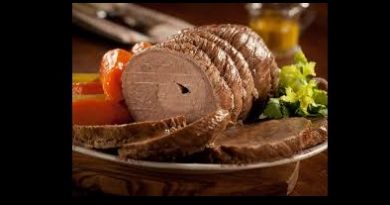How to Process Ponmo (Cow Skin) at Home and Earn from it.
How to Process Ponmo (Cow Skin) at Home and Earn from it.

Nigeria’s colorful cuisine contains a variety of meats, one of which is the most popular condiment and snack known as “ponmo.”
Have you ever wondered how ponmo is produced? How to Cook Ponmo? What is Ponmo?
Butchers prepare dry ponmo food, which is cow skin in English. It’s a delectable cut of beef that’s used in a variety of soups and eaten as a snack.
It is usually found in the southwest of Nigeria (among the Yorubas), although it can also be found in other regions of the country.
There’s just something beautiful about properly cooked cow skin meat. I especially enjoy it when it’s gently cooked in a stew and the sauce seeps into the cow skin crevices, oozing out of every corner as you bite into it (oh my).
We’ve all heard stories about cow skin food dealers injecting it with various substances for it to become softer faster and appear thick and plump. Thereby making consumption highly dangerous.
If food safety is a priority for you, you might wish to make your own.
Do you know how they say there are multiple ways to skin a cat? That holds for ponmo as well. There are various methods, but this is my personal preference for home cooks.
Process – How to Cook Ponmo
- Firstly, cut the cow skin into manageable pieces.
- After that, scrape the dirt from the back of the skin.
- Thirdly, trim away any surplus meat from the cow skin inside.
- Then, trim away any surplus meat from the pomo’s inside. The meat should be washed and dried.
- Preheat the oven to 400 degrees Fahrenheit and line an oven pan with foil.
- Arrange the pieces on the lined baking sheet and bake. Curl and dry the pieces in the oven. (Time: 25–30 minutes)
- Take the cow skin out of the oven. Fill a big saucepan halfway with water and add the coiled pieces. Cook for 30 minutes to 45 minutes.
Take the ponmo out of the water and set it aside to cool. Cut into the desired shapes and sizes.
The color of the cow, as well as scraping, determines the final color of your pomo. Brown cows create brown pomo, while black and white cows generate white ponmo.
How to make money or earn from Ponmo: Start a Ponmo Business in Nigeria
- After the process, you can sell it right away.
- You can make a sauce with pepper and sell it as well.
Do you think it’s a good idea to make your pomo at home? What more do-it-yourself dishes would you like to try?
Let me know in the comment section below. I enjoy hearing from you.
Cow skin
Cow skin, commonly known as beef tripe, is the edible lining from the stomach of cattle. While it may not be as popular as other cuts of meat, it is consumed in various cuisines around the world.
Here are some potential benefits of cow skin meat:
Rich in Protein:
Like other meat products, cow skin is a good source of high-quality protein. Protein is essential for building and repairing tissues, supporting immune function, and maintaining overall health.
Collagen Content:
Cow skin is rich in collagen, a structural protein that is crucial for maintaining the health of skin, joints, and connective tissues. Collagen is also known to promote skin elasticity and joint flexibility.
Nutrient Density:
Cow skin contains various nutrients, including vitamins and minerals such as iron, zinc, and B vitamins. These nutrients play important roles in various bodily functions, including energy metabolism, immune function, and blood formation.
Potential for Gelatin Production:
Cow skin can be processed to produce gelatin, a substance with various culinary uses. Gelatin is often used in desserts, soups, and various food products. It may also have some health benefits, such as supporting joint health and improving skin condition.
Cultural and Culinary Diversity:
In many cultures, cow skin is used in traditional dishes, adding diversity to the culinary landscape. The preparation and consumption of tripe vary widely, and it is often included in stews, soups, or grilled dishes.
It’s important to note that while cow skin can offer nutritional benefits, it may not be suitable for everyone. Some people may find the taste, texture, or odor unappealing.
Additionally, individuals with certain dietary restrictions or health conditions may need to be cautious about consuming certain animal products.
As with any food, moderation is key, and it’s essential to consider individual preferences and dietary needs.
If you have specific dietary concerns or health conditions, it’s advisable to consult with a healthcare professional or a registered dietitian for personalized advice.
What nutritional benefits does cow skin meat offer?
Cow skin meat, also known as beef tripe, is rich in high-quality protein, essential for tissue repair and immune function. It contains collagen, promoting skin and joint health, and provides essential vitamins and minerals such as iron, zinc, and B vitamins.
How does the collagen in cow skin meat contribute to health?
Collagen is a structural protein found in cow skin meat that supports skin elasticity, joint flexibility, and connective tissue health. Consuming collagen may contribute to improved skin and joint health.
Are there any specific nutrients in cow skin meat that are noteworthy?
Yes, besides protein and collagen, cow skin meat contains essential nutrients like iron, which is important for blood formation, and zinc and B vitamins that play roles in various bodily functions, including metabolism and immune support.
Can cow skin meat be beneficial for those looking to boost their protein intake?
Absolutely. Cow skin meat is a good source of protein, making it a valuable addition to a diet aiming to meet protein needs. Protein is crucial for muscle maintenance, repair, and overall body function.
Are there culinary uses for cow skin meat?
Yes, cow skin meat is used in various traditional dishes around the world. It can be included in stews, soups, or grilled dishes, adding cultural diversity to culinary practices.
What precautions should individuals take when consuming cow skin meat?
While cow skin meat has nutritional benefits, individual preferences and dietary restrictions should be considered. Some people may find its taste or texture unappealing, and individuals with dietary restrictions or health conditions should consult healthcare professionals for personalized advice.
Can cow skin meat be processed into other products with health benefits?
Yes, cow skin can be processed to produce gelatin. Gelatin has culinary uses and may offer benefits such as supporting joint health and improving skin condition.
How should cow skin meat be included in a balanced diet?
Cow skin meat can be part of a balanced diet when consumed in moderation. It can be prepared in various ways, ensuring a diverse and nutrient-rich approach to overall nutrition.
Remember, individual dietary needs vary, and it’s advisable to consult with healthcare professionals or dietitians for personalized advice based on specific health conditions or concerns.


Pingback: How to Remove Hair from Cow Skin - 9jafoods